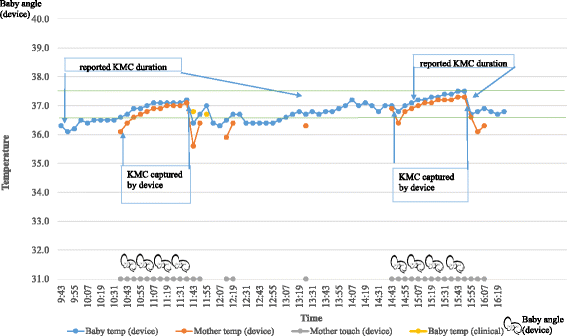Continuous, real-time monitoring of neonatal position and temperature during Kangaroo Mother Care using a wearable sensor: a techno-feasibility pilot study
- PMID: 29796294
- PMCID: PMC5961490
- DOI: 10.1186/s40814-018-0293-5
Continuous, real-time monitoring of neonatal position and temperature during Kangaroo Mother Care using a wearable sensor: a techno-feasibility pilot study
Abstract
Background: Remote biomonitoring of vital parameters in hospitals and homes has the potential to improve coverage and quality of maternal and neonatal health. Wearable sensors coupled with modern information and communication technology now offer an opportunity to monitor temperatures and kangaroo mother care (KMC) adherence in a continuous and real-time manner remotely for several days' duration in hospital and home settings. Using an innovative remote biomonitoring device to measure both temperature and baby position, we undertook a techno-feasibility study in preparation for a clinical trial.
Methods: We designed and developed a wearable sensor for tracking KMC adherence and neonatal temperature, using social innovation design principles. After screening mother-infant dyads using clinical and logistic eligibility criteria, we piloted this wearable sensor along with a gateway device and the commercial cellular network. The dyads were recruited during hospitalization and followed up in the hospital and home phases for several days. Simple descriptive statistical analysis was undertaken.
Results: Recruitment rate was 50% (6/12), and consenting rate was 83% (5/6) during a 2-month period. These five neonates contributed a total of 39 study days (15 hospital days and 24 home days). Their mean [± standard deviation (S.D.)] birth weight was 1490 (± 244) g.The mean (± S.D.) of the vital signs for the five babies was temperature [36.5 °C (± 0.3)], heart rate [146.5/min (± 14)], and oxygen saturation [94% (± 4)]. No severe or moderate side-effects were noted; one baby developed mild dermatitis under the device that was transient and self-limiting, yielding an incidence proportion of 20% and incidence rate of 2.6/100 person-days.None of the mothers reported any discomfort with the use of the device. Temperatures detected from 81 paired readings revealed that those from the wearable sensor were 0.2 °C lower than those detected by clinical thermometers [36.4 (± 0.7) vs 36.6 (± 0.3); < 0.001].There was also iterative feedback that was useful for hardware and software design specifications of the wearable sensor, the gateway device, and the analytics platform. Lastly, lessons were learnt with regard to the logistics of research team interactions with healthcare professionals and study participants during the hospitalization and post-discharge home phases of the study.
Conclusions: The pilot study has shown that it is feasible and acceptable to track KMC adherence as well as maternal and newborn temperatures in a potentially safe manner on a real-time mode for several days' duration during hospitalization and home phases. The pilot has also helped inform modifications in clinical monitoring, technological modifications, and logistics planning in preparation for the definitive clinical trial.
Trial registration: Clinical Trials Registry of India, CTRI/2017/09/009789.
Keywords: Kangaroo mother care; Monitoring; Neonatal health; Signs; Temperature; Vital; Wearable sensor; mHealth.
Conflict of interest statement
The study was approved by the St John’s Institutional Ethics Review Board (IERB # 360/2015 dated 12 Jan 2016). Informed consent was obtained from parents.The authors declare that they have no competing interests.Springer Nature remains neutral with regard to jurisdictional claims in published maps and institutional affiliations.
Figures




References
-
- Registrar General of India (RGI) Sample registration system bulletin. New Delhi: Government of India; 2014. p. No. 1.
LinkOut - more resources
Full Text Sources
Other Literature Sources

